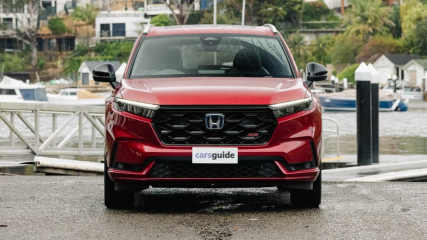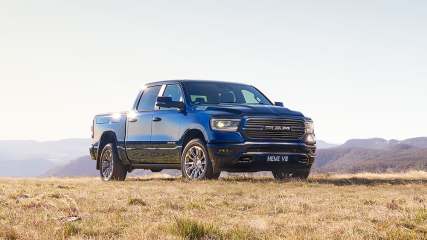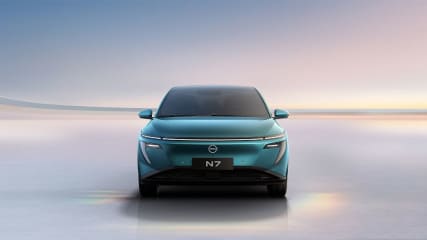How are they all going to survive? Big US style pick-up trucks, utes, 4WDs and Australia's favourite brands that will struggle under NVES | Opinion
By Tom White · 22 Dec 2024
Modern emissions regulations are finally in force in Australia thanks to the introduction of the much-discussed New Vehicle Efficiency Standards (NVES).In force from January 2025, the new legislation catapults Australia’s emissions laws from the 1980s into the 21st century, essentially harmonising our standards (for C02, at very least) to the emissions regime in Europe.From this year until 2029 an ever tighter fleet C02 average will be imposed on automakers in Australia.It may initially seem this could limit the choice of models available to consumers, but it will instead serve to change the dynamic that local distributors and factory-backed outfits have with their respective factories, opening access to models, which before were unavailable, or are actually more suited to sync up with strict Australian Design Rules (ADR) or the safety standards imposed by our local crash-test body, ANCAP.The legislation is also specifically designed to stamp out the practice of using Australia as what some describe as a “dumping ground” for old-technology engines, which are otherwise only sold in developing markets.The light-speed introduction of the rules from virtually nothing won’t be without casualties. Some vehicles, even perennial favourites in Australia, are under threat from these new rules. Some manufacturers are well prepared with a range of hybrids and EVs to help bring their fleet average down, others are scrambling for solutions to improve their otherwise comparatively high-polluting vehicle line-ups.To be clear, these brands will continue to be able to sell these high-emitting engines. It’s not an outright ban. Some V8s, V6s, big capacity four-cylinders and diesels will continue to be sold, so long as their manufacturers are able to sell enough electric vehicles, hybrids and plug-in hybrids to bring their total fleet average down. The only other option? Pay the fines, which could mean the costs are passed on to consumers.So, which brands are most exposed from 2025 onward, and what are they doing about it? Let’s take a look.Isuzu is enormously popular in Australia considering it sells just two vehicles, the D-Max ute and MU-X SUV. The problem is both models are largely famous for their rugged 3.0-litre four-cylinder turbo diesel engine sourced from the brand’s light commercial truck range.This high-emitting engine, plus the fact that Isuzu doesn’t have a range of passenger cars, hybrids or EVs to fall back on as part of its international range, means the Japanese stalwart might be the most at-threat of any mainstream brand in Australia right now.So what’s the plan? Isuzu has already introduced the smaller and more emissions-friendly 1.9-litre four-cylinder engine from its Thai range, which looks to be followed up by its recently-announced 2.2-litre four-cylinder big brother.Lighter, cleaner, and potentially equipped with 48-volt mild hybrid technology, this engine could buy Isuzu the time it needs to get its EV ute plans off-the-ground.Even though Ford remains one of Australia’s most popular brands, this popularity is almost entirely due to just two models, the Ranger and Everest, both are powered by relatively high-emitting diesel engines. To make things worse for Ford, its lower-emitting Euro-sourced SUVs don’t seem to sell in Australia (in fact, the underrated Puma and Escape were both discontinued here recently).Its only other popular vehicle, the primarily V8-powered Mustang, certainly doesn’t help the equation, and uptake has been tame for the Mach-E electric SUV. Ford cancelled its plans to launch the promising Puma Gen-E in Australia, which it seems simply can’t compete with Chinese alternatives on price.What’s Ford doing about it? As is the case in Europe, it is leaning more heavily into its commercial vehicles. It has introduced a range of electric and hybrid Transit vans in hopes fleet customers will take up the low-emissions volume it needs to off-set its utes, which are overwhelmingly popular with private buyers.The Ranger PHEV will also no doubt help, but could have limited appeal with its specs not looking impressive compared to the recently-launched BYD Shark 6.Jeep is another brand full of big and off-road focused vehicles, which look set for a headlong clash with NVES rules.The brand’s 3.6-litre naturally-aspirated V6, which still lives in some of its vehicles, is a comparative dinosaur of a unit. It provides the old-school combustion thrills its audience is looking for, but the problem is it emits well in excess of the 140g/km requirement to avoid NVES fines.Unlike some of its rivals, Jeep is at least having a red-hot go at introducing plug-in hybrids and electric vehicles, with the Avenger electric small SUV recently landing in Australia.On top of that, as CarsGuide currently understands the situation, NVES is measured at an OEM level, meaning its Stellantis parent may be able to off-set every big-engined Jeep it sells with a hybrid Alfa Romeo or something fully electric from its incoming Chinese joint-venture brand, Leapmotor.Will they sell in big enough numbers to off-set Jeep’s most popular model, the Grand Cherokee? Time will tell.Like Jeep above, Subaru’s current primarily naturally aspirated range of relatively high-emitting signature boxer engines put it on a collision course with NVES rules.Subaru might be least at risk of the options here though, because it is deep in the process of rolling out hybrids to join its lone EV model, the Solterra.The Solterra hasn't proved as popular as its rivals, but buyers are champing at the bit for the coming next-generation hybrid Crosstrek and Forester SUVs. They use Toyota's hybrid tech blended with the brand’s signature boxer engines.But wait, there’s more working against Subaru. 2027 is not far away, and by then the final stage of NVES will even be putting pressure on currently popular plugless hybrids, which the brand is only just now getting its hands on. Will Subaru be able to keep up? We’ll have to wait to see how its new model plans in 2025 shake out to get an idea, as representatives from its Inchcape importer declined to comment on the impact of NVES on its range at this time.Mahindra’s fledgling new-generation offerings in Australia are a major reset for the Indian marque, with a big increase in spec and quality proving to be a step-change, really giving it a better shot in Australia.The problem is right now, the brand is exclusively bringing in relatively high-emitting turbocharged petrol and diesel engines for its large vehicles, a recipe for emissions beyond the scope of NVES rules.Mahindra is working on a solution though, promising its incoming next-generation range of electric vehicles will feature heavily in its Australian line-up as soon as it can get its hands on them. Additionally, it may be able to off-set emissions from its larger vehicles with its recently-revealed 3X0 small SUV, which could prove to bolster its Australian hopes in more ways than one.Whether it will be enough to off-set its incoming next-generation diesel dual-cab remains to be seen.One of Australia's favourite brands has precisely zero electric vehicles on sale, despite an expansive passenger car range and an offering in almost every segment.Sure, its range of new engines for its large vehicles are impressive. Even though they’re big straight-sixes, they use innovative hybridised transmissions in an attempt to offer its buyers the best of both worlds. Combine that with a range of plug-in hybrids, and Mazda might well just buy itself some time. It will need to do something about its also relatively high-emitting 2.0-litre petrol four-cylinder engines, which feature in its range of hatchbacks and small SUVs.The brand recently announced it will introduce a range of lower emissions replacement engines from 2027. Dubbed SkyActiv-Z, the new engine family will burn leaner and theoretically reduce emissions without the need for electrification, and the brand said it will also borrow Toyota hybrid tech for some of its next-generation core vehicles.There’s little zero-emissions vehicles on the immediate horizon. The local division has denied it will need to dig into its Chinese joint-venture and introduce the EZ-6 sedan (at a price that will actually sell), but it almost seems an inevitability with NVES rapidly closing in.Ineos offers just one 4x4, and it looks like exactly the sort that will fall afoul of NVES rules. The Grenadier off-roader is heavy, four-wheel drive, and six-cylinder combustion powered.It is also on a ladder frame, which buys it a higher bar to beat, and its BMW-sourced engines are inherently Euro-6 compliant.The company’s local boss, Justin Hocevar, told CarsGuide at the launch of the Quartermaster ute variant that it was likely the brand would also lean on BMW for engines with upgraded mild hybrid (MHEV) technology in the short term to help it achieve its emissions targets.Additionally, he noted the smaller Fusilier, which will be available with both battery electric and range extender hybrid, was not cancelled, just put on pause for the time being as the brand globally responds to a retraction in EV demand.An EV pioneer turned laggard, Nissan is in trouble when it comes to emissions in Australia. Unlike Honda, which could potentially switch to an entirely hybrid-only range to buy itself some time, Nissan will need to radically overhaul its range of passenger vehicles in just a handful of years if it wants to avoid NVES wrath.Sure, it has introduced the appealing range-extender e-Power hybrid tech on its best-selling Qashqai and X-Trail, but the system isn’t efficient enough to off-set the amount of Navaras or petrol V6 engines it sells.Its trailblazing Leaf EV is now gone and the mid-size Ariya electric SUV is still nowhere to be seen, leaving future hopes in the hands of the small SUV Leaf replacement due to be revealed next year.Ram is arguably a worse position than Isuzu. Its importer, Ateco, has ditched the V8 1500 for next year and is replacing it with a twin-turbo V6, but it isn't likely to fare much better in emissions tests. As CarsGuide understands, Ateco isn’t allowed to spread its emissions across its brands in contrast to its factory-backed group rivals.This means every big Ram could be looking at a major price increase if its emissions aren’t allowed to be offset by Ateco’s LDV Chinese commercial vehicle marque, which is expected to move quite a few electric Deliver 7 vans and eTerron 9 utes in the next year.It puts the brand in quite a spot going into 2025, as much of its success has been due to the bulk of its 1500 sales sitting right in the circa-$130,000 sweet spot, which seems to attract buyers to the ‘full-size’ American pick-up space.



.jpg)

_0.jpg)
.jpg)
.jpg.jpg)
.jpg)
